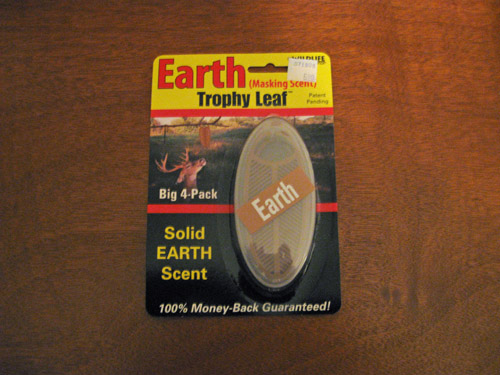
This is going to be a short review because it’s negative and there’s not much to say. I picked up these solid scent “leaves” for use on a recent deer hunting trip because the scent wafers I had been using for several seasons had finally lost their scent. It’s not that these don’t smell like dirt, they do, just not very much. There are four leaves in the package compared to three scent wafers in the product I normally use, but the scent of the other product is much stronger.
I drop the wafers into a plastic trash bag with my clothes after washing my duds in scent free laundry detergent and drying them with masking scent dryer sheets. I’ll provide more information about the detergent and dryer sheets I like in future reviews, but for the time being let me say that Fresh Earth cover scent wafers from Hunter’s Specialties are similarly priced and the scent is much stronger. When you open the container on the H.S. product, the smell is almost enough to knock you down. The degree of accuracy in reproducing the scent is also phenomenal. You’ve smelled this scent before if you’ve ever opened a container of nightcrawlers or kicked all the rotting leaves out of a spot to sit down when hunting from the ground. Yup, the H.S. wafers smell like straight-up dirt, and that’s a good thing. The Trophy Leaf has a similar smell, but it’s just not enough to scent my whole bag of clothes the way the other product does. The Trophy Leaf is not a bad product, but there are others that are better. You heard it here.
Tags: Reviews from the Armchair
“So we made a lot of tall talk and some side bets on who would catch the most fish and the largest. Some of us went to bed later than we normally did. Drunker, too. We slept above deck and under the stars, with the boat rocking just enough so that when you rolled over and wondered where you were you’d feel it and remember.”
- Geoffrey Norman, “Sea of Plenty,”Esquire, September 1981
Tags: Words of Wisdom
Forend cracks are a common problem with Browning Auto-5s. The wood is necessarily thin to accommodate the magazine tube and the recoil spring. The barrel snapping back into battery hits a pretty good lick, and the impact is rough on the tiny ridge that slides into and mates with the front of the receiver. The recoil spring itself can also contact the inside of the forend and set up some pretty vicious vibrations. There is a pin through the forend to reinforce it close to the magazine cap, but running cracks often appear on the receiver end. With some of the heavy loads I prefer for pheasant shooting, it was inevitable that I would develop a similar problem. Although I’m sure a professional could have obtained a cosmetically more acceptable result, I needed the thing working, and fast, for an upcoming shoot. Even with a professional repair, there would be no guarantee that the problem would not present itself again, and none of my guns are museum pieces anyway.
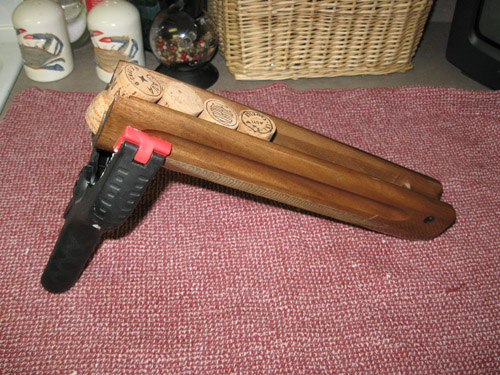
My solution was to spread the crack as far as I could and shoot the thing full of Gorilla Glue. It bonds wood fairly well, and more importantly, it would expand to fill the crack. There is very little bearing surface for gluing, and I wanted as much adhesion between the two halves of the split as possible to prevent the crack from running. Gorilla Glue is also flexible enough when dry that I’m hopeful it won’t act as a wedge to split the piece the rest of the way.
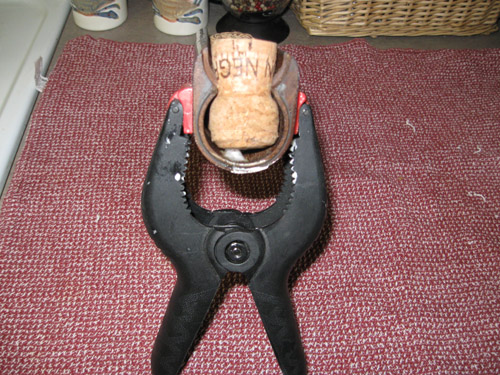
Notice how the glue is foaming and bubbling out of the crack. Because the glue expands quite a bit, I had to use a clamp to make sure it didn’t all run out or force the crack to open wider. Tolerances are pretty close between the receiver and the lip, so any swelling of the forend would cause a fit issue. I found that a champagne cork is just the right size on a 12 gauge forend to hold everything in the proper relationship. Luckily, I happened to have several lying around. I told you I had champagne taste and a beer budget, right? Melody in Orange Beach calls me Champagne Mike. I’ve been called a lot worse.
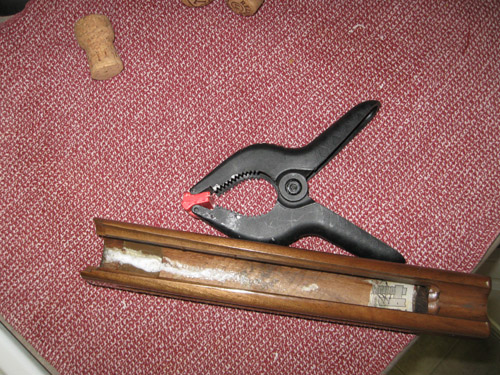
Here’s the finished result. Notice in the right of the photo how the action of the recoil spring has worn away the factory sticker that describes the placement of the friction rings for 3-inch magnum loads. There’s some pretty serious rockin’ and rollin’ inside that forend when shooting the big boomers. I guess reduced loads would be more gentle on the components, but I’m American: harder, faster, louder, better!
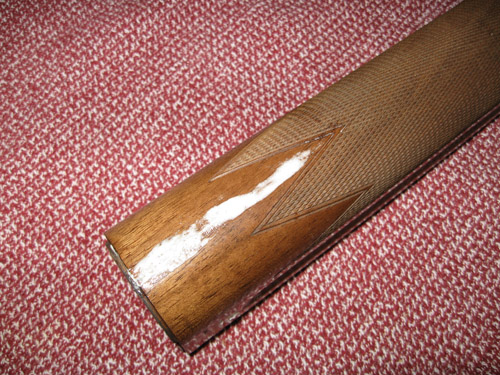
The repair is clearly visible from the outside because the glue is so light in color. I didn’t do any sanding; I put the whole works back together and shot the next day with no ill effects. It certainly wouldn’t pass muster with a professional re-stocker, but it got me back in the field with minimal down time and expense. That’s armchair.
Tags: Guns





